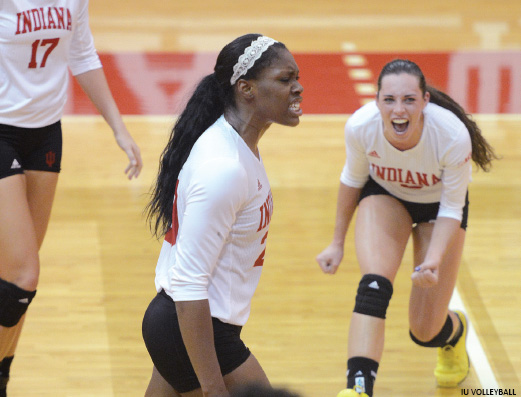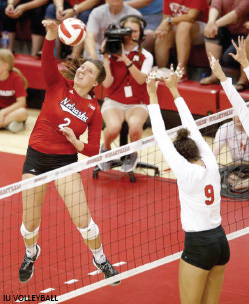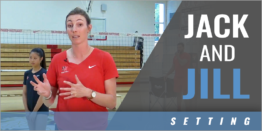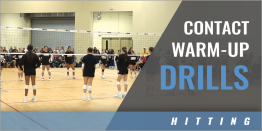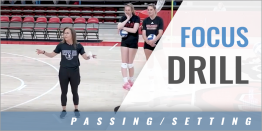|
By: Jim Miret - Front Range Volleyball Originally Published in: Coaching Volleyball Copyright/Provided by: American Volleyball Coaches Association Most volleyball coaches want their players to be fit, strong and well conditioned. The question we want to ask in this article is strong and fit for what? Do we want them to be fit like soccer players or basketball players, strong like football players, or conditioned like track athletes? If you were preparing for a 100-meter dash, would you run 5Ks to prepare yourself? If you were attempting to be a bike sprinter, would you condition by swimming? If you were conditioning to be a ski racer, would you condition by sprinting? Of course you would not do any of the above examples. Why then would we have our volleyball players participate in activities that do not look like our sport or have them work out for durations that are not similar to our sport? Conditioning should be done in as similar an environment as possible to get the training effect you desire. This article will specifically address how we can better condition our volleyball teams through how we practice. Conditioning: What is it and what does it look like in practice? One day my strength coach and I were talking and we were hit by a revelation. We were discussing conditioning our athletes during the season, and specifically how the body adapts to stimulation. In order for our bodies to make adaptations, the stimulation must be consistent and present over an extended period of time, and specific to the energy system(s) used in volleyball.
Overall, we came to the conclusion that we've observed many volleyball coaches conditioning their players in a way that was not ideal when it came to developing the energy system that we use most in volleyball - the anaerobic energy system. An average set played in volleyball lasts about 20 minutes. We realized that many coaches are conditioning their players for the average length of a set - so drills often run for minutes on end with front row players taking jump after jump before they get a break. The belief here is the more the athletes do the more conditioned they will become and the game will get easier to play. When considering a conditioning plan for your athletes, it's important to understand a bit more about the internal functions within the body. Specifically, any time we are practicing, we are "training" different energy systems in our bodies, so it's important to know which energy system is in use most for volleyball so that we can maximize the performance of our athletes. Here is what I learned from our team about energy systems: The Phosphogen (Anaerobic A-Lactic) energy system last about 10 seconds and is for high-power, short-duration moves or sports. The Glycolytic (Anaerobic Lactic) system takes over after the first 10 seconds and lasts for about two minutes. This system is for moderate-power, moderate-duration moves or sports. The Aerobic energy system is for durations of more than two minutes where low power and long duration is required. These energy systems are a mixture of intensity of moves and duration of performance. The volleyball spike and block are high-power moves and are primarily fueled by the Phosphogen system. When performing a high-power move like a spike or a block, rest cycles are required for the energy system to refuel and dispose of waste products produced. Here is how we look at conditioning in practice for volleyball performance at FRVBC. In a closely played set, each team will play about 50 points. This means that in a single day of competitive play at a tournament or qualifier a team could play anywhere from 300 to 400 points. We believe it is important to prepare our teams to be able to tolerate a 400-point day, rather than conditioning them to play 20 minutes in a row without a break. Here is some more data to consider. We surveyed six 18 Open junior female sets from medal winning teams and found that the average point lasted approximately six seconds. The time between points (also known as the rest cycle) was roughly 15 seconds. The longest rallies lasted approximately 20 seconds and occurred about 10% of the time. We also surveyed six sets from the top four women's teams in the 2012 Olympic Games, and found the average point lasted about 10 seconds, and time between points lasted 20-30 seconds. The maximum point length was 30 seconds and happened about 10% of the time. This data tells us the more we can make practice look like points with the correct work-to-rest ratio, the better conditioned our athletes will become to play our sport. Each point is a unique work bout followed by a rest cycle. Our goal is to condition our athletes for these bouts of work and rest cycles. So our athletes can give medium to high intensity, recover and give the effort again without any drop-off in performance. Remember, you are conditioning your athletes for 50 sprints, not one 5K race. To improve anaerobic conditioning, rest cycles need to be included to permit time for the energy system to recover. Without a rest cycle you begin training aerobically, with is not the energy system used in volleyball. Intensity and volume must also be considered when planning practices. The higher the intensity of a drill and the longer the duration, the more rest will be necessary to allow the athlete to recover before engaging in the intense activity again. The lower the level of intensity, the longer you can have your athletes do it, with less recovery time necessary. As we progress through the season we want our practices to mimic the intensity, duration and rest cycles that we observed in the number of points played and the rest between points from the elite level volleyball games we surveyed. The goal over time is to condition our athletes to produce more cycles of maximal effort combined with recovery time, or in the example of volleyball, points.
Conditioning: Practical application in volleyball So, how can you put this into practice with a team? The best method for training the anaerobic system that we have discovered is to train at a high intensity for approximately 6-15 seconds, followed by 15-20 seconds of rest. It is fine to have bouts of 90-120 seconds at a time with high to moderate intensity, as long as there is ad-equate recovery time before the athletes are required to engage again (2-5 minutes or so of rest/lower intensity activity). Here are some examples of drills and what criteria to look at. An example of lower-intensity drills could be a typical passing drill. Here, players are normally making moderate- to low-intensity moves, and could be repeating them for minutes at a time. An example of higher-intensity drills would be high-repetition digging with all-out moves to balls, continual blocking or attacking moves. Also any time you are playing repetitive points without stopping. In all of these examples the total duration your athletes are engaged must be monitored. If you try to have players do continuous max jumps without a break, they will fatigue very quickly (15-20 seconds). If you have them do 1-3 max jumps and cycle out while 2-3 other players take their turn, this gives the athletes adequate recovery time before they engage in the activity again. This will allow you to train them a bit longer (about one minute), and increase their conditioning. In addition to drill intensity and duration, we believe we should also count the number of points played when game play (scrimmage) is occurring in practice. In order to prep our teams to compete, we slowly increase the duration of high-intensity drills and we start counting points in the competition (scrimmage) section of our practice. As we approach our first three-day event we try to get to 150 points played in most practices in the competition phase of practice. This increases slowly over the next few months to around 250 points per practice in the middle of the qualifier season. And as we approach nationals we reached 300-350 points per practice on heavy days and 200 points per practice on moderate days. Of course we cycled in some easy days, about one per every three days or so. We want to look at conditioning as a process that takes place over a season. Volleyball (as do all sports) has very specific needs in skill and energy system development. In the beginning of the season, you may spend over 50% of your practice time in drills that are slower and lower in intensity while developing skill. Early in the year you can alternate high-intensity drills with lower-intensity drills to allow your players a chance to recover. As your season progresses, the percentage of higher-intensity drills needs to increase, with adequate rest cycles planned into practice. By the end of your season you should be doing most of your practice at the intensity and duration necessary to complete a day(s) of competition. We have found fluxing between 60 and 90% of the points you will play in an event day has been very good for our athletes. We also work hard to respond to their fatigue level by cycling in easy days when they are warranted. Take a look at your practice plans - How much of your practice are spent in high-intensity drills? Are your players getting adequate time to recover following bouts of high-intensity work? Is there an opportunity to make a few adjustments to better condition your athletes? The answer just might surprise you! |




